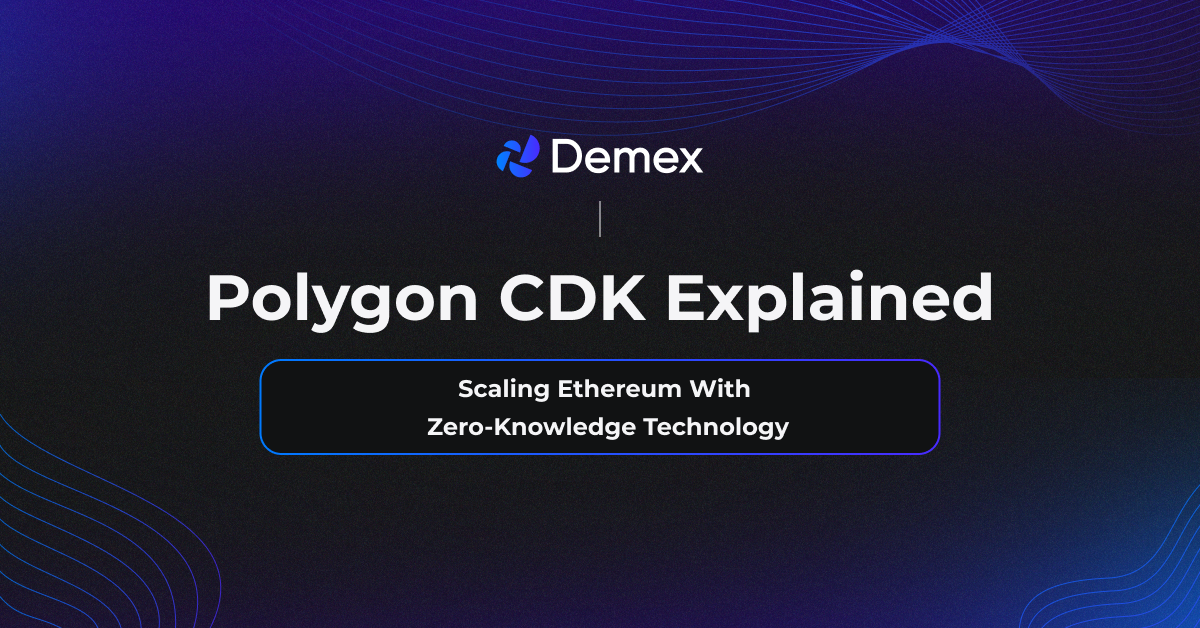Polygon CDK Explained

Ethereum's scalability challenges have been a long-standing issue, hindering its widespread adoption. In response, various projects are actively seeking solutions to scale Ethereum, and among them is Polygon. Polygon, previously known as Matic Network, functions as both a Layer 2 scaling solution and a sidechain for Ethereum. To further enhance scalability, Polygon introduces its Chain Development Kit (CDK), a framework designed to empower developers in building modular, zero-knowledge (ZK) powered Layer 2 blockchains on Ethereum.
Understanding Ethereum's Challenges
To comprehend the significance of Polygon CDK, it's crucial to first recognize the challenges Ethereum faces. As a leading blockchain platform, Ethereum struggles with transaction speed and fees, impacting the seamless operation of decentralized applications (DApps) on its network.

Enter Polygon: Bridging the Gaps
Polygon, formerly known as Matic Network, steps in as a dual-layer scaling solution and sidechain for Ethereum. By introducing additional processing layers around Ethereum, Polygon reduces congestion and improves transaction efficiency. This sets the stage for a smoother transition to understanding the role of Polygon CDK in the broader context of blockchain evolution.

Zero-Knowledge Proof: A Privacy Boost
Before delving into Polygon CDK, we explore an essential component of its architecture – zero-knowledge proofs (ZKPs). This cryptographic technique enhances privacy and security on the blockchain. Understanding ZKPs provides a foundation for appreciating the privacy-centric features Polygon CDK brings to the table.
Zero-knowledge proofs (ZKPs) are a cryptographic technique enabling one party to prove knowledge about a specific piece of data without revealing the actual data itself. In the context of blockchain, ZKPs add a layer of privacy by allowing a party to cryptographically demonstrate to another party that they possess certain information without disclosing the information itself. This becomes particularly relevant in situations where smart contract use cases require privacy due to business or legal reasons, such as using proprietary data as inputs to trigger smart contract execution. ZKPs on blockchain networks reveal only that some hidden information is valid and known by the prover with a high degree of certainty.
The mechanics of zero-knowledge proofs involve a verifier instructing a prover to perform actions that can only be accurately executed if the prover possesses the underlying information. If the prover is merely guessing, they will eventually be proven wrong by the verifier's test with a high probability. Zero-knowledge proofs can be either interactive or non-interactive. Interactive ZKPs involve convincing a specific verifier, while non-interactive ZKPs allow a prover to generate a proof that can be verified by anyone using the same proof. The three essential characteristics of ZKPs include completeness, soundness, and zero-knowledge, ensuring that honest verifiers can be convinced by honest provers, dishonest provers cannot mislead honest verifiers, and the verifier gains no additional information beyond the truth of the statement.

Unveiling Polygon CDK: Empowering Developers
Polygon CDK is an open-source framework for developers to build and deploy ZK-powered Layer 2 blockchains on Ethereum. It facilitates the transition of existing Layer 1 chains into Ethereum Layer 2s and ensures interconnectivity between all blockchains built using the CDK. Leveraging zero-knowledge proofs, Polygon CDK prioritizes modularity, scalability, and composable interoperability.

Advantages of Polygon CDK
High Modularity: Developers can customize Layer 2 chains according to specific app requirements, ensuring optimal blockchain efficacy for each application.
Enhanced Scalability: CDK chains act as individual Layer 2s, reducing Ethereum congestion and improving throughput. Developers can customize scalability approaches without burdening Ethereum.
Unified Liquidity: Polygon CDK promotes unified liquidity, enabling seamless asset transfers across various chains within the ecosystem, benefiting both Polygon and Ethereum's digital economy.
Robust Data Availability: CDK-based chains have a dedicated Data Availability Committee (DAC) to guarantee reliable off-chain data access, enhancing data integrity and resilience.
Composable Interoperability: The LXLY bridge by Polygon ensures seamless interaction between CDK-based chains, promoting cross-chain collaboration and expanding the functionality of the entire blockchain ecosystem.
How Polygon CDK Works
Polygon CDK consists of three primary components:
Validium: Enables off-chain processing of transactions with ZK-based validity proofs, enhancing transaction speed and efficiency while ensuring data integrity.
Data Availability Committee (DAC): A secure consortium of nodes within CDK ensures consistent off-chain data accessibility, even when Layer 2 operators might be offline.
LXLY Bridge: Facilitates interoperability within the Polygon CDK ecosystem, allowing seamless interaction and asset exchange across various blockchains.
Live Projects Built on Polygon CDK
Several live projects demonstrate the practical applications of Polygon CDK across various domains, from finance to NFT infrastructure. Canto, Astar Network, and Palm Network are notable examples leveraging Polygon CDK for scalable and secure operations.

Building Apps on Polygon CDK Chains
Developers can simplify building apps on zk-rollups using the Polygon CDK with thirdweb, offering pre-built and audited smart contracts for various use cases. These contracts can be deployed securely on any EVM chain, including those built on the Polygon CDK stack.
The TLDR
Polygon CDK marks a significant advancement in scaling solutions for Ethereum, combining the power of Layer 2 scaling and zero-knowledge proofs. With its high modularity, enhanced scalability, unified liquidity, robust data availability, and composable interoperability, Polygon CDK opens new possibilities for developers and businesses aiming to build on Ethereum. As the blockchain ecosystem evolves, Polygon CDK stands as a promising technology, poised to play a crucial role in the race to scale Ethereum and unlock the full potential of decentralized applications.
The TLDR: ELI-5 Version
Imagine Ethereum as a playground for games, but too many kids want to play, and it's a bit slow. Polygon CDK is like building a new playground next to it, just for games. It has a special tool (CDK) that helps game makers create their own cool areas (chains) with faster games.
The tool uses magic checks to keep things safe and has friends (Validium, DAC, LXLY Bridge) to help. Now, different games (projects) from other playgrounds can come and play together, making everything more exciting! Kids (developers) can use pre-built tools (thirdweb) to set up their games easily. It's like adding extra fun zones to the Ethereum playground, making games faster and more fun for everyone!

